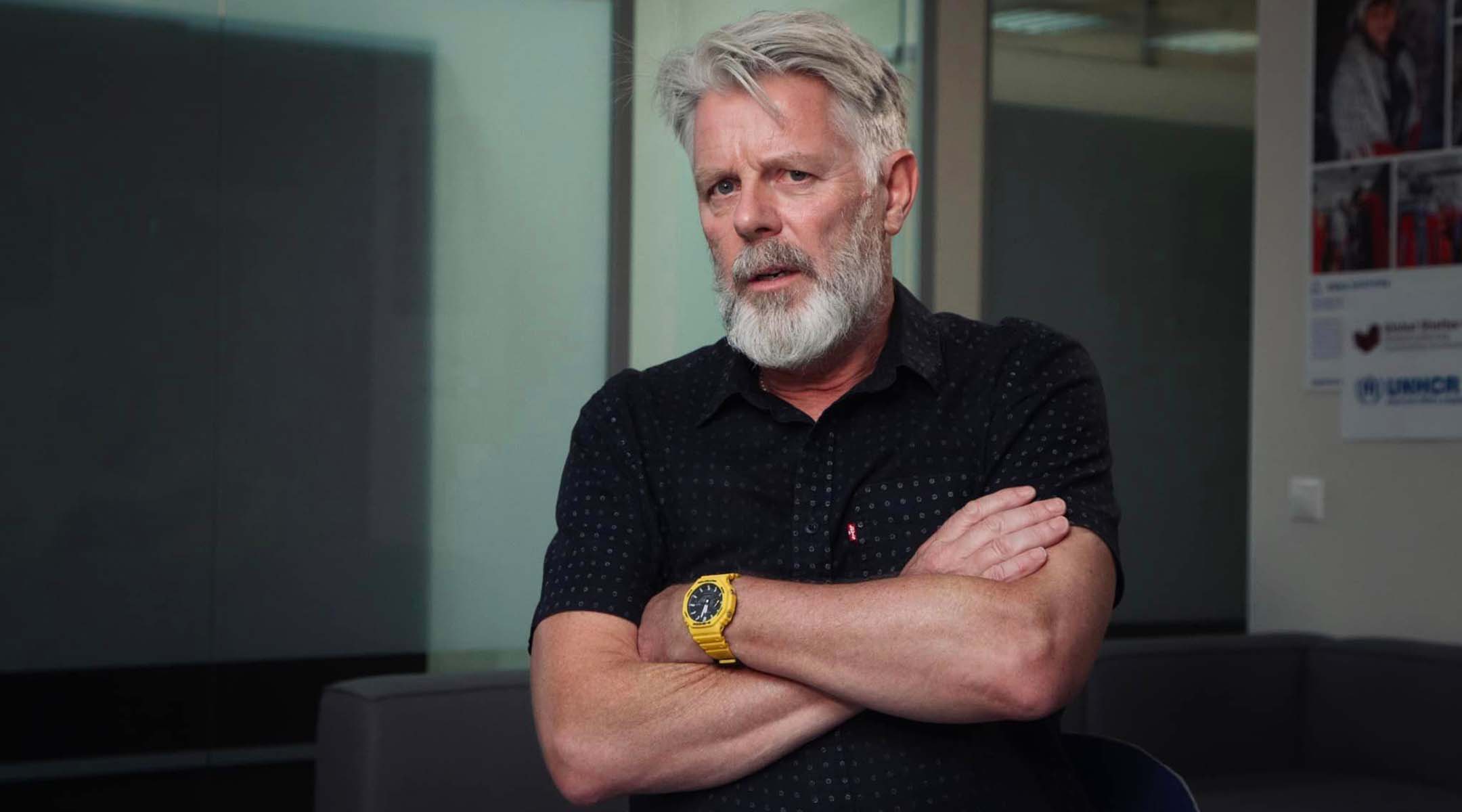Since the beginning of Russia's full-scale invasion, the UN Shelter and Non-Food Items Cluster in Ukraine has provided humanitarian assistance and shelter to 1.6 million Ukrainians. John Wain, Shelter and Non-Food Item Coordinator in Ukraine, who has been involved in humanitarian missions worldwide for over 30 years, told Ukrinform about the type of assistance provided and winter preparations. The Cluster team is well aware of Ukraine’s needs during the war. John Wain has repeatedly witnessed massive Russian missile attacks, providing emergency shelter to Ukrainians in Dnipro.
THE MAIN ACTIVITIES
- What are the main activities of the UN Shelter and Non-Food Item Cluster in Ukraine?
- First of all, we should explain what the Cluster is. The Cluster system was developed back in 2005 after the previous crisis that didn't go so well. I've been in Sri-Lanka after the tsunami in 2004, and the coordination of humanitarian activities was not going well. There was a lot of competition between agencies to secure projects and coordination between all actors was not adequate. It was chaos. So, as part of the humanitarian reform process, the cluster system was introduced in December 2005 to address this lack of sectoral coordination and improve leadership technical support, and accountability of humanitarian response.
Twelve sectors developed into clusters, including the Shelter and Non-Food Items (NFI) Cluster. The Cluster system has been activated in Ukraine for several years now. Immediately before the full-scale Russian invasion, it was in the process of handing over activities to the Government of Ukraine. When the full-scale Russian invasion happened, the system had to be reactivated for coordination and technical support.
- What projects have been implemented since Russia's full-scale war against Ukraine started?
- The primary activities of the Shelter and NFI Cluster are needs assessment, service delivery support, planning and strategy development, monitoring and evaluating performance, building national capacity on shelter and non-food items issues and advocacy/fundraising. So, for 2023, one of the components of the Humanitarian Response Plan was to identify 8.3 million people within Ukraine in need of shelter and non-food item support.
We are targeting 3.3 million to help in 2023, and our estimation for all these activities amounts to $525 million. To date, we have reached 1.6 million people, with approximately 27% of funding. To date, we have received funding of $145 million out of the $525 million needed.
Generally, shelter needs and conditions fall under three pillars: first, the shelter itself, the structure could be a simple prefabricated existing building or tent, also everything to live comfortably within the shelter. This is the ability to cook, take a sleep, and to live contentedly within this building – that is the second pillar and the third is outside the shelter services – healthcare, education, infrastructure, and transport.
The three referenced pillars:

- What are the non-food items?
- It is a middle pillar to provide people with what they need for a normal life. We have the Technical Working Group designing non-food items kits. The household kit consists of items for cooking – pans, pots and all things for cooking, sleeping equipment, matrasses, blankets, and items for hygiene – so this is what we mean by non-food items. These items are consolidated into a kit that the agency with partners can procure, preposition, and then distribute.
We have non-food items kits for winter, so we design kits to support people through the upcoming winter. We put it together as a kit with consultation with our partners and the Technical Working Group. We would devise specifications for these items and pricing. That's generally what non-food items consist of.
- What about accommodation and temporary housing projects?
- The shelter pillar consists of activities to shelter people immediately following the crisis. Let's say it was an attack on the city, and hundreds of houses were damaged. We have developed emergency shelter kits with plastic sheeting, battens, nails, and wood boards. These kits will be prepositioned to the locations for rapid distribution so people can have adequate accommodation immediately following the strike.
Moving up from that, we have activities called light repair of houses that consists of repairing roofs and windows, price range of $1,500 to $2,500, and medium repairs – price range of $2,500 to $4,000. If the repairs are significant, we have heavy repairs that will involve structural support and be far more expensive, from $5,000 to $15,000.
The agency is also doing modular homes such as prefabricated housing. These are manufactured structures with a minimum standard. We follow guidance on cost and required space for a person (SPHERE Standards). So, these modular houses have been built and delivered to the people whose homes were completely destroyed. However, the camps using modular housing are costly and would differ from our first preference for the Shelter Cluster.
Generally, the unit costs approximately $ 20,000, and when you create camp-type settings, there is a lot of dependency. People depended on the agency and units we and other Cluster’s partners provide - that dependency is hard to stop. Sustainability is essential, as is access to services. The community needs to get access to infrastructure, education, and schools. These services must be in place before we settle a community. We have modular houses, but it wouldn't be our first choice of response.
Another response we have is rental support. We are supporting people with rent – to fund the rent payments for up to six months if people's house has been destroyed. We implement a rental program trying to be connected with households because sustainability is important. Once people get rent for six months, we cannot continue paying this rent, and people have to be able to look for themselves afterward (connection with livelihoods actors). We also work in collective centers, generally schools, hostels, and university hostels. Their buildings were remodeled for the people in crisis. A lot of work last year was done to repair the collective centers and accommodate the internally displaced people during the war.

- How do you identify whom to help first?
- There are 8.3 million people who need the shelter / NFI support, and we can't afford to give this amount of support. We have identified the most vulnerable, working closely with the Protection Cluster on the criteria. We established which people needed support the most. Single-headed households, the elderly, and families with disabled members – are our priority support, and we are working very closely with local authorities on beneficiaries. Local authorities know their community, and they can share lists with our sub-hubs, after we provide support to these people who are the most vulnerable.
- In which regions are the Cluster's activities most present? What are the priorities?
- The Cluster is very active in the east. We have four Shelter Cluster’s subnational hubs in Ukraine. There is a national hub here in Kyiv. We have the east hub in Dnipro, another central hub is in Vinnytsia, and the west hub is in Lviv.
In the east, it is primarily the emergency shelter response. The most needed activities in the east are the non-food items kits, the emergency shelter kits, and the light repair of housing.
In the center and west of the country, we have more collective centers where people are displaced, most of all they need a place to stay. The Cluster renovated collective centers, and we are active with the rent support. It is a different response geographically spread, but the primary focus is obviously on the frontline regions in the east.

PREPARING FOR A DIFFICULT WINTER
- The next winter could be very tough for Ukraine. Is the UN going to help and support Ukrainians in the wintertime?
- Winter response consumed us for the last month, we developed winter recommendation guidance. We have been extremely busy with winter preparations targeting 1.1 million people. We estimate that $200 million is needed for S/NFI activities in Ukraine this coming winter. In collaboration with our partners, we have developed the Working Group for winter recommendations. These recommendations outlined where and what our response should be. We developed kits specifically for winter – high-thermal blankets, matrasses, winter closing, electrical heaters, and solid fuel heaters. Another big part is the fuel – firewood, coal briquettes. We are working closely with the Ministry of Reintegration on what the costs are, and what support is required in every region, and then we match these requirements with the plans of our humanitarian partners.
Last week, we had a good meeting on the Ministry's current mapping requirements. Also, the agency will provide in-kind support, which means that the agency's partners are actually purchasing firewood and fuel and deliver. The other modality is cash - this modality is often the preference of large organizations. Delivering in cash means we have to fully understand the markets. Doing market assessment on what fuel is available in various regions is another huge part of what we need to coordinate as the Cluster in order to support delivery through cash mechanisms, which in the current environment is the preferred response of the agency because procurement could be challenging.
- How can an ordinary Ukrainian get UN assistance?
- The first protocol for ordinary Ukrainians is the community groups and the local authorities. First, they should contact city and regional authorities to get support – it is the primary protocol.
The Cluster cooperates with the authorities on beneficiary lists, which is coming through local authorities. Volunteer community groups cannot be praised enough in Ukraine. We were in Khmelnytskyi last week. There was a strike on the military construction there, which hit over 350 houses, and this is outside the east zone.
It is something we should be very conscious of – these strikes are happening all throughout Ukraine. Just focusing on the east will not be fair. We have to get a balanced approach. Three hundred fifty houses were damaged, and we have been able to coordinate the delivery of construction – roof shiffer, glass windows, plastic, and nails - so that people are able to do the work themselves. The community mobilized workers to help, and even the school boss transported his workers from house to house – it was incredible to see. The strength and usefulness of ordinary Ukrainians is often underestimated. Frequently, respondents to the crisis are the people themselves, and they are hugely strong. For the people who need support, it should be local community groups and local authorities.
PERSONAL EXPERIENCE
- You are probably traveling to the hostility areas yourself. Do you feel danger? How do you keep up with it?
- There is always an element of danger. Particularly, when you first arrive and see alerts on your phone, it's quite scary. I think the longer you are here, the more familiar you are with it. I don't know if it is a good or a bad thing. Definitely, it's important to follow security protocols. UNHCR has very strict security protocols. It could be very scary and shocking what is going on here. Personal security is a primary concern for all foreigners in Ukraine
- Maybe it was a particular situation you’ve been in?
- I have been doing this humanitarian work for over 30 years now and have found myself in some scary situations. Recently, when I was in Dnipro, massive attacks were going on, and some explosions happened so quickly, that it was difficult to move to the shelter quick enough. It was far from us, but it is a horrible and shocking reminder of what could easily happen if you were in the wrong place at the wrong time.
Oleksandr Klitina, Kyiv
Photo credit: Kyrylo Chubotin
